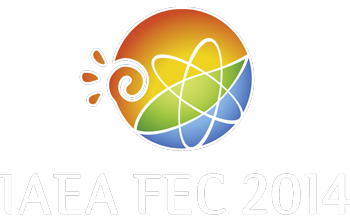Speaker
Mr
Basilio Esposito
(ENEA)
Description
The determination of the threshold density value to be achieved by means of massive gas injection for runaway electron (RE) suppression in ITER relies on the relativistic collisional theory of RE generation which predicts that, below a critical electric field (E_R), no runaway electrons can be generated. No account of additional loss mechanisms, that may reduce the critical density, is usually made in the above treatment.
Past experiments by means of electron-cyclotron-resonance heating in the flat-top phase of FTU discharges had shown that runaway suppression is found to occur at electric fields substantially larger than those predicted by the relativistic collisional theory of runaway generation. This was found to be consistent with an increase of E_R due to the electron synchrotron radiation losses, which lead to a new electric field threshold (E_R_rad).
The main aim of this work is to verify whether the earlier finding that synchrotron radiation losses play a role in runaway generation is also confirmed in FTU discharges with no additional heating. Recent experiments in FTU have systematically investigated the conditions for RE generation in stationary and reproducible conditions (flat top of ohmic discharges) for a wide range of plasma parameter values: toroidal magnetic field (Bt=3-7.2 T), plasma current (Ip=0.35-0.5 MA) and Zeff (1.5-15).
The threshold electric field for RE generation was measured using feedforward gas programming to obtain a decreasing electron density until RE are generated. The results indicate that the measured threshold electric field is larger by a factor ∼5-10 than expected according to the purely collisional theory and is very close to the new threshold calculated including synchrotron radiation losses (∼2E_R_rad).
| Country or International Organisation | Italy |
|---|---|
| Paper Number | EX/P2-50 |
Author
Mr
Basilio Esposito
(ENEA)
Co-authors
Mrs
Afra Romano
(ENEA)
Mr
Antonio Botrugno
(ENEA - Unità Tecnica Fusione)
Mr
Cesidio Cianfarani
(ENEA)
Mrs
Cristina Mazzotta
(ENEA)
Dr
Daniele Marocco
(ENEA)
Dr
Francesco Belli
(ENEA)
Dr
Giovanni Artaserse
(ENEA)
Mr
Giuseppe Ramogida
(ENEA)
Dr
Jose Ramon Martin-Solis
(Universidad Carlos III de Madrid)
Mr
Luigi Panaccione
(ENEA)
Mr
Marco Riva
(ENEA)
Mr
Onofrio Tudisco
(ENEA)
Mr
Salvatore Podda
(ENEA)
Mr
Valter Cocilovo
(ENEA)
Mrs
Zana Popovic
(Universidad Carlos III de Madrid)

